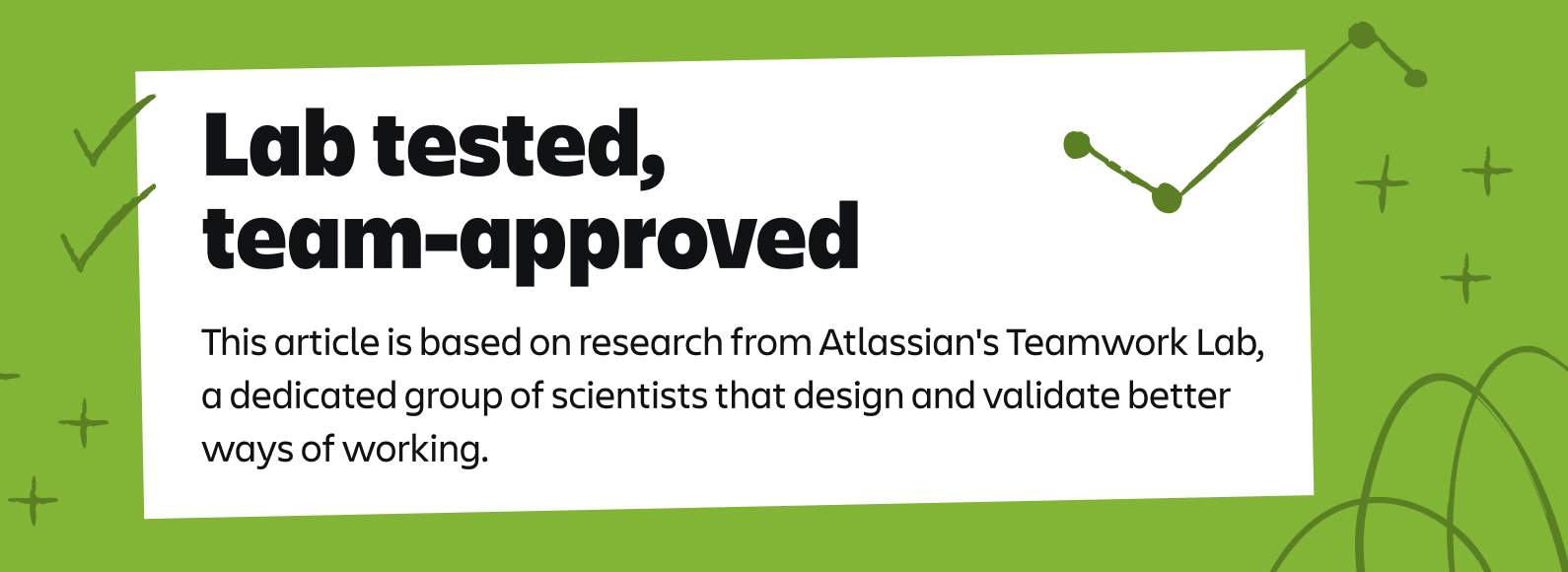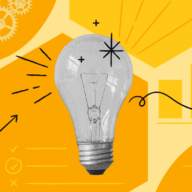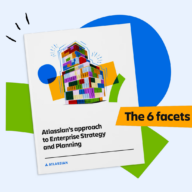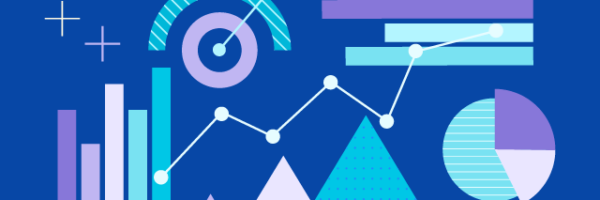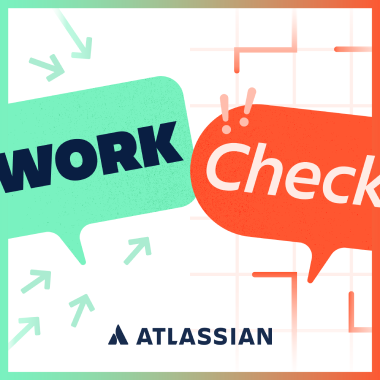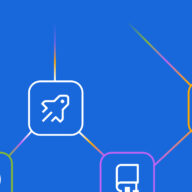Have you ever spent way too long searching for that one message, with that one link, to that one deck you need to move your project forward? And when you ultimately couldn’t find it, you scheduled a meeting or DMed a coworker to get the info?
You’re not the only one. In fact, 56% of workers say they often find that the only way to get the information they need is to ask someone or schedule a meeting. And when information lives in inboxes, DMs, or people’s heads, AI can’t help you either – because AI can’t surface what isn’t documented online. That leaves your team stuck reinventing the wheel in silos or sitting in endless meetings instead of building on each other’s learnings.
56% of workers say they often find that the only way to get the information they need is to ask someone or schedule a meeting.
But when you put information online – where teams and AI can easily access it – and keep that information up-to-date, you build a rich knowledge base that’s accessible to everyone. The benefits are clear: shorter meetings, less wasted time searching, faster decisions, and cooler outcomes.
Our research shows the following practices help high-performing teams unleash collective knowledge – and avoid those “wait, where is that?” moments altogether.
Turn scattered information into a competitive advantage
Better knowledge sharing starts with better habits, including:
- Putting information online, where your team and AI can easily access it
- Sharing info async (so you can use meetings to actually do the work)
- Prioritizing content quality over quantity
- Working with AI to surface and manage knowledge
No one wants to spend their life digging through messages, pinging a million coworkers, or stuck in meetings that could have been an email. They want to quickly get the info they need, so that they can get shit done and solve meaningful problems.
Below are three research-backed practices to turn institutional knowledge into faster and smarter decisions.
Practice 1: Replace meetings with documented communication
Too many meetings are used to share information or talk about doing work, which eats up time and leaves no accessible record. Replace these with high-quality written materials and short videos.
Make room with short videos and written messages: On Monday, look at your calendar for meetings where you’re only planning to share an update or a demo. If you’re a manager, look at your 1:1s. Is there anything you plan to repeat in every meeting? Try recording a short Loom video instead, or sending a written update (e.g., via Slack). This scales the information you want to share, centralizes group discussions about it, and frees up time for focused work.
Share priorities via async updates: Send monthly video or written updates that connect current priorities to company goals. Create an ongoing dialogue where teams can understand context, raise concerns, and align their work – all without scheduling another meeting.
Try the Play: Weekly Team Updates
Try page-led meetings: For necessary meetings, start with a document that outlines context, goals, and key discussion points – then capture decisions made (AI can help you with this!). This page then becomes part of your company’s shared knowledge system.
Atlassian’s Teamwork Lab tested this approach. Here’s how it works:
- Before the meeting: Create a concise page outlining context and decisions needed.
- During: Attendees spend 10 minutes silently reading and commenting on the page.
- After: The page captures feedback, decisions, and next steps – becoming a living document.
The result? Meetings became more energizing, inclusive, and efficient. They sparked more creative ideas and made it easier for everyone to contribute.
Try the Play: Page-Led Meetings

Practice 2: Prioritize content quality over quantity
Create high-value content that’s clear, trustworthy, and properly labeled. This way, your team can quickly find exactly what they need without wasting time wading through clutter.
Be clear and concise: Nobody has time to read a novel when they’re trying to solve a problem. Clear, to-the-point messages cut through the noise and drive action. When your async communication answers what people need to know and why they should care, teammates can quickly find what they need and take action.
Involve multiple contributors before sharing widely: Have several contributors review and add to pages before sharing them beyond the team. This quality check creates stronger content while reducing content overload.
Adopt organized transparency: Make early-stage work accessible to all, but flag status by clearly indicating whether content is a work in progress or officially approved. Use tags and distinct spaces to show if content is early thinking, ready for feedback, or official guidance. This lets everyone learn from and build on each other’s work while knowing what they can rely on.
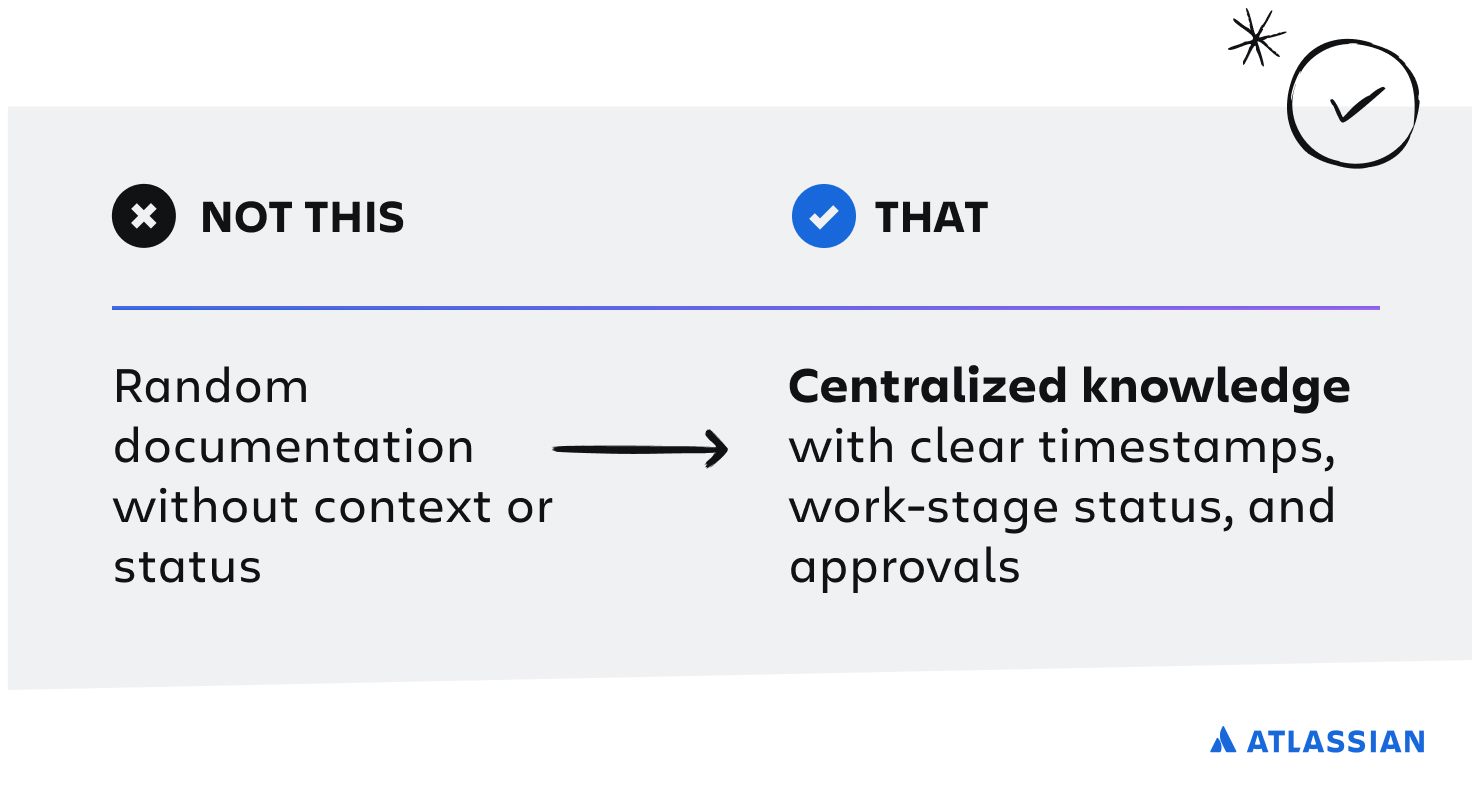
Practice 3: Work with AI to get the info you need, fast
With AI, teams can translate information into insights that power their work – if and only if they collaborate in ways that build a connected knowledge base.
Put everything online so AI can access it: Create a go-to place for information about goals, projects, and teams. When knowledge is searchable and up-to-date, it becomes a powerful tool for alignment, smarter decision-making, and innovation.
Create rituals around updating documentation: Build simple habits and collaborate with AI to make sure documentation is current. When teams update knowledge regularly, AI can surface the right information at the right time – and people can trust what they find. Use AI to generate transcripts and summaries of video meetings and Looms, turning conversations into searchable text that becomes part of your knowledge base.
Search first, ask last: Override the instinct to ping colleagues when seeking information. Instead, work with AI to search existing documentation first. This preserves everyone’s focus time while still getting you the answers you need, and is faster than waiting for a human response.
Find what you need instantly with Rovo Search
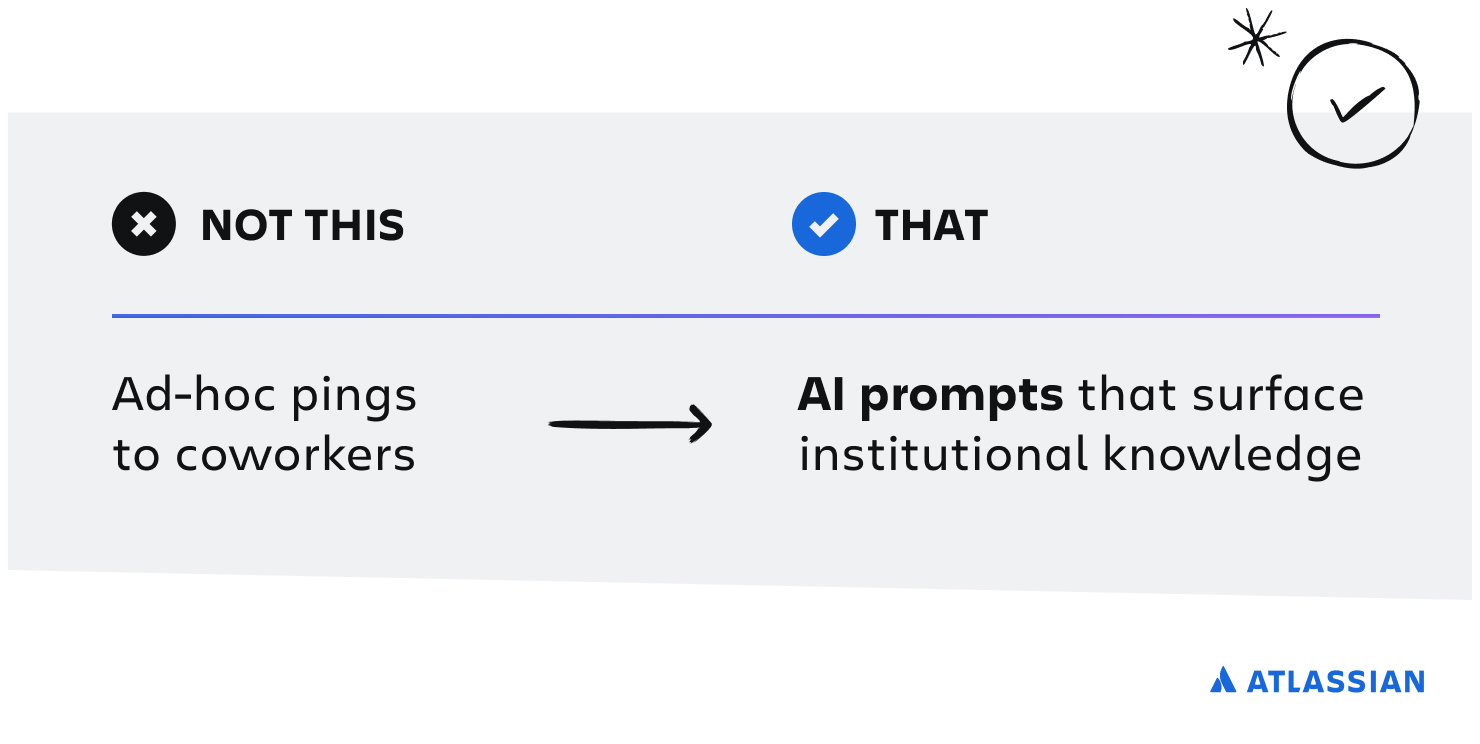
How Atlassians used video updates to save 5,000 hours of meeting time in two weeks
Atlassians have been using Loom since 2016, well before our companies joined forces in 2023. In March 2024, Atlassian’s Team Anywhere Lab launched a company-wide challenge: replace one meeting with a Loom video. We wanted to see if this simple swap could help reduce our meeting overload while keeping teams connected across time zones.
We targeted the obvious candidates: meetings where one person does most of the talking, like presentations, status updates, demos, and project kickoffs.
[molly sands Loom]
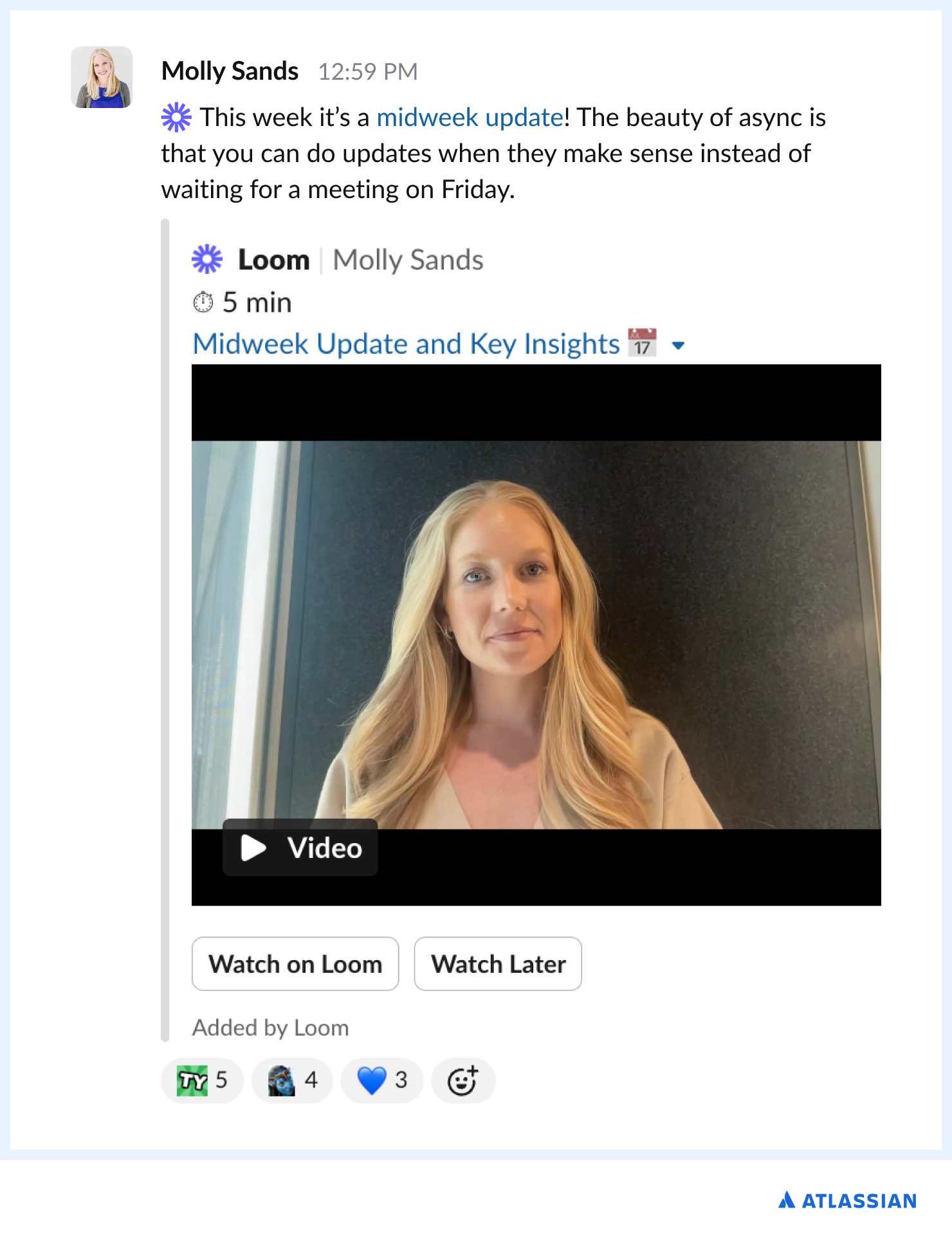
The results? In just two weeks:
- 93% of Atlassians watched a Loom
- 43% of Atlassians replaced a meeting with a Loom
- This
freed up 5,000 hours for focused work (that’s 2.5 years of working time)
- Average views per Loom video increased 1.5x during the challenge
- Emoji reactions from viewers on Loom increased 63% (a sign people were engaged with the content)
After the experiment, Communications Manager Marques shared, “Using Loom disrupts the pattern of waiting until the ‘next meeting’ to talk through a topic … Being able to record a Loom means I don’t have to wait, and neither do my colleagues.” Senior Product Manager Will added, “My team is across the globe, so Loom has been a great way for us to all stay in sync, async. The ‘show, don’t tell’ nature leads to higher quality interactions.”
The verdict was clear: async communication doesn’t just save time – it drives connection, collaboration, and team learning.
Using Loom disrupts the pattern of waiting until the ‘next meeting’ … Being able to record a Loom means I don’t have to wait, and neither do my colleagues.
Marques, Communications Manager
Information management is just one piece of the teamwork puzzle
Making information easy to access is critical, but it’s most effective when combined with three other pillars of the Atlassian System of Work (our core philosophy for making teamwork work):
- Align work to goals: High-performing teams don’t just set goals – they set fewer, bolder goals that tie directly to the company’s strategic priorities. They build systems and rituals that make those goals clear, actionable, and continuously relevant. Learn more.
- Plan and track work together: When teams are clear on how the work will get done and why they’re doing it, they move faster and make better decisions. Turning goals into concrete actions with visible progress keeps everyone aligned. Learn more.
- Realize the full power of AI teammates: AI can help teams cut through information overload, gain insights faster, and accelerate innovation cycles – but only when it’s treated as a true teammate with clear roles and responsibilities.
What could your team accomplish if everyone had easy access to a rich knowledge base? When teams can learn from each other, it doesn’t just speed up work – it’s the key to turning company insights into a competitive advantage.
